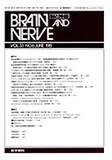Japanese
English
- 有料閲覧
- Abstract 文献概要
- 1ページ目 Look Inside
はじめに
水頭症および脳浮腫での脳紺織の変化については,組織学的,生化学的にさまざまな手法を用いた検討がなされてきた20,22,23)。そのなかで組織液の性状,出現と消失の過程が大きな課題の一つになつている25)。一方,近年プロトン核磁気共鳴法(1H-NMR法)をin vitroで生体組織に適用することにより生体における水についての分子論的な検討がすすめられてきた。それによると,生体組織では水分子は自由に拡散するのではなく,高度に組織化され束縛された状態にあるというモデルが提唱され8),病的過程ではそうした水の秩序が乱される可能性が示唆されている9)。1H-NMR法(以下単にNMR法と略す)によれば,組織を破壊せずまた外来のプローブを用いずに生体組織中の水につき検討を加えることができ,正常組織と浮腫組織での水につき有用な検索が可能である。そこで今回われわれは,実験的に作成した血管障害性脳浮腫およびkaolin水頭症でのPVL (perive—ntricular lucency)を対象に,NMR法を用いた解析を試みた。NMR-CTの実用化が目前に迫り16),灌流臓器や切除標本だけでなくin vivoでの測定が可能になりつつある現在1,12),基礎研究の積み重ねがより重要になつてきていると考えられる。
The pulsed NMR technique is very sensitive to molecular movement because its observation fre-quency is in the range of the rates of molecular movement. Furthermore it makes it possible to study the interested molecules in the biological tissues physically and noninvasively. In this report we have investigated the experimental brain edema and hydrocephalus, in both of which the tissue fluid changes are main pathology, through 1H-NMR relaxation study of water molecule in the brain tissues. The longitudinal (T1) and the transverse (T2) relaxation times were measured with Varian-HR-220 spectrometer modified with Nicolet-TT-100 PFT system. The experimental materials were the adult male Wistar rats suffering from cold injury edema and the adult canines suffering from kaolin hydrocephalus. The study showed firstly that in brain edema no particular changes were found for relaxation times in the white matter, whereas in the gray matter, discrepancy between the changesof T1 and T2 was observed. That is to say, there were 2 components of T2 in contrast with single T1 value in the same sample of the edematous gray matter, which indicates the existence of 2 fractions of tissue water, not exchanging on an NMR time scale. Secondary, a good correlation between the longitudinal (T1) relaxation time and the tissue water content was found for the dog brains, which suggests that we can analyse the NMR relaxation data of the dog brains based on the two-fraction fast-exchange model.

Copyright © 1981, Igaku-Shoin Ltd. All rights reserved.


